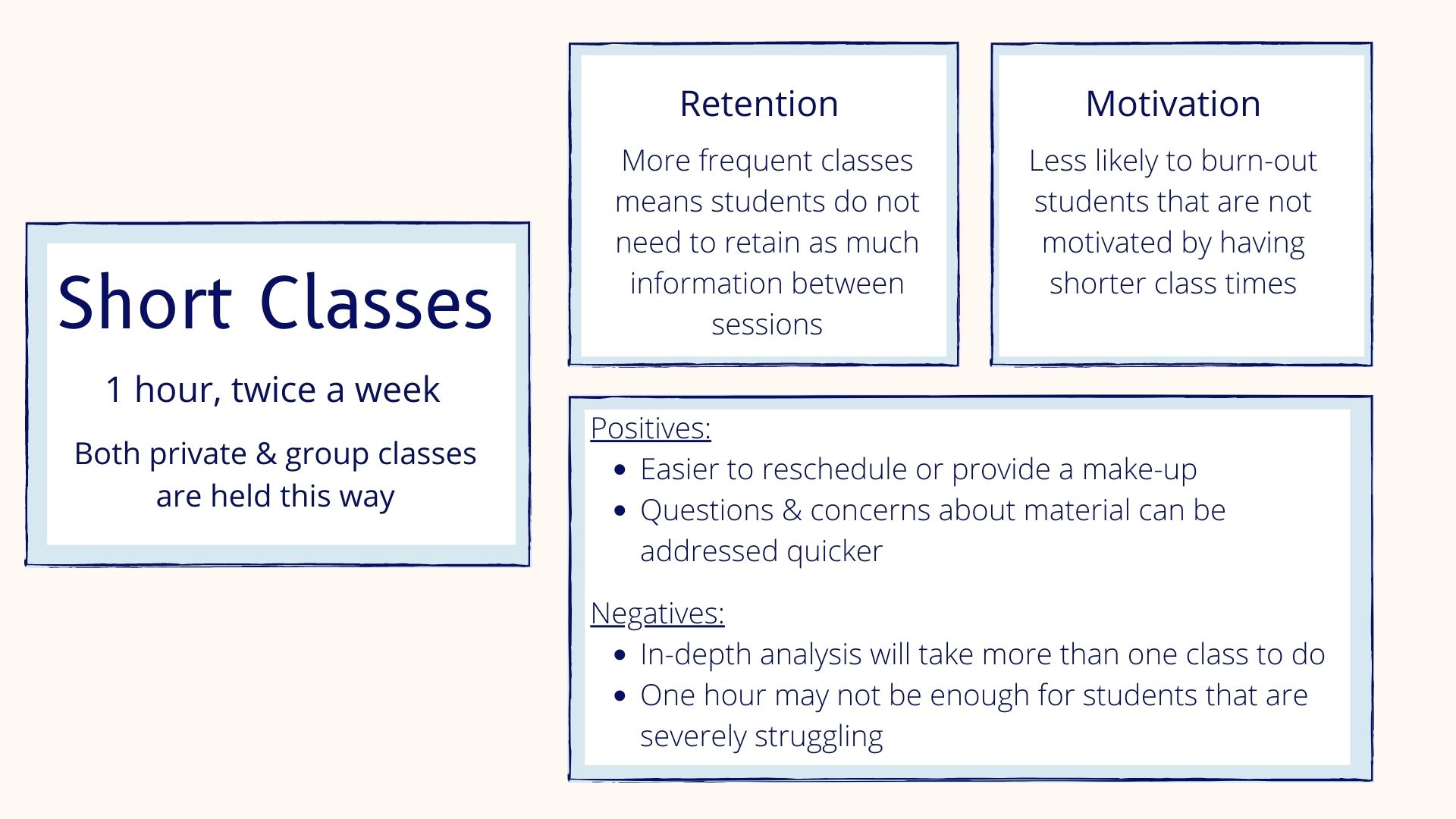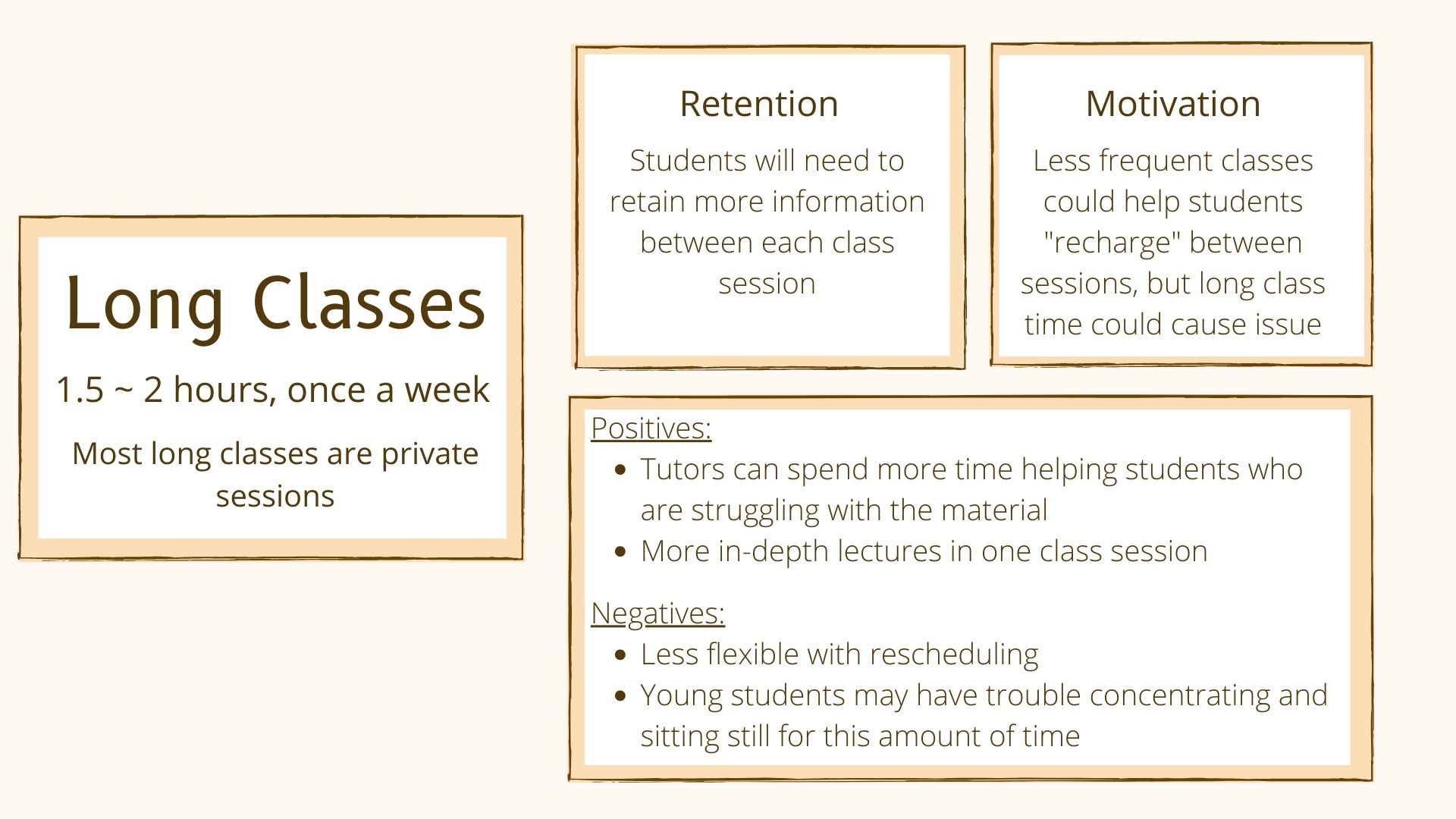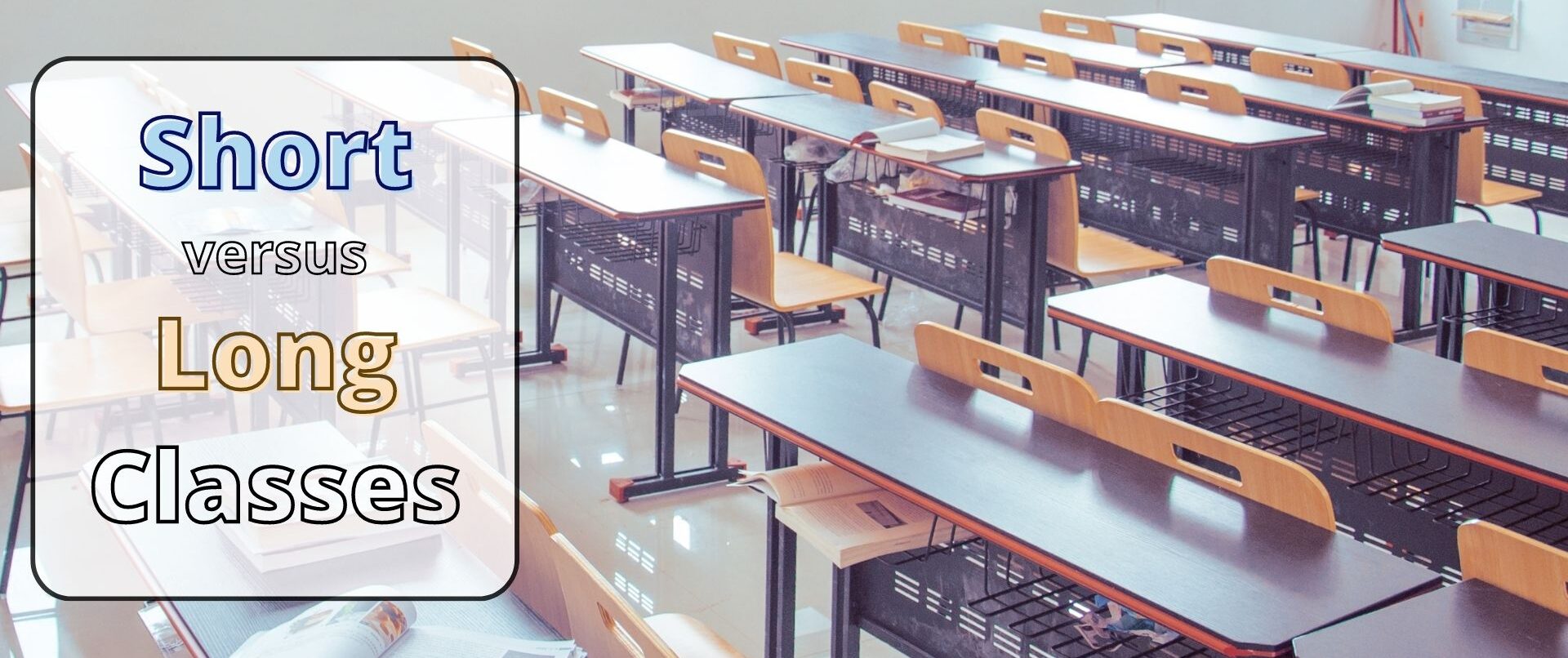Tutoring is surprisingly full of benign decisions. Aside from choosing the subject that you want your student to study, there are a myriad of other, smaller decisions that need to be made to determine what kind of course would be the most effective. What are their weakest points? How frequently do you want their lessons to be? Are there specific learning goals you want to meet? And so on. Amongst these questions, there is one that is often not considered by parents – or perhaps not considered carefully enough: “How long do you want your student’s class time to be?”
When we ask parents this question, many of them turn it around on us: what do we, as the professionals, think is best? The issue is that, if this is the first time we’re meeting your student, we do not have enough information to make that decision. It is irresponsible to claim that one way of scheduling the classes is better than the other when each student’s needs and learning goals are unique.
So, assuming that there is no other activity that may cause a scheduling issue, how can you decide what type of class schedule ensures your child gets the best results?
Before thinking about what class schedule would work best for your student, it is important to understand the importance of retention and motivation.
To put it simply:
Retention is how much information a student is able to remember between classes. If a student has high retention, then they can remember things they learned in class weeks ago, so large gaps in between classes do not pose an issue since students can start right where they left off. A student with low retention however, might need a refresher for concepts they have not touched in class for some time. To be clear, in this scenario, one student is not better than the other. They simply have different needs.
Motivation is how excited and willing a student is to be in a learning environment. Highly motivated students are eager to be in class, but this also means they might want to take classes more frequently or for longer periods of time. Students without much motivation can be impatient and have a low threshold for class length. Most students, however, fall somewhere in-between these two extremes and will differ based on subject, teacher, class size, and other factors.
By knowing a student’s level of retention and motivation, we have a common base to compare the different class schedules offered at Honor Academy. Successful students need a class schedule that strikes a balance between the frequency they need to maximize retention, while also finding a rhythm that keeps up their motivation.
Option #1: Short Classes
One of the scheduling options is short classes. These are one hour long and hosted twice a week. This schedule is used by both private one-on-one classes and group classes like book club.
Students who have trouble retaining information will benefit from short classes because there is less time in between each session, so they are constantly refreshing themselves on what they have learned. However, if there is a student who missed a session and was not able to schedule a make-up class, the limited time means that there is a risk that a student who frequently misses classes will fall behind.
Motivation for a short class, on the other hand, is like a double edged sword. Students who are not motivated to attend class may like the shorter classes and become less easily burnt-out. However, students that refuse to work or put in the effort will not have enough time in one session to obtain substantial results. Since tutors will spend most of the time coaxing them into working, the student will have less time to put pen to paper.
Students and parents who have busy or unpredictable schedules will also have an easier time rescheduling and making-up missed sessions because the shorter time allows for more flexibility in the tutors’ schedules.
While some students take short classes once a week rather than twice a week due to scheduling complications, we discourage parents from doing this whenever possible. Unless the student has both high retention and high motivation, this schedule carries all the negatives of short classes without the positives.
Overall, short classes are most beneficial for students with low retention whose motivation is average or just below average.

Option #2: Long Classes
The other option we offer for scheduling is long classes. These are between one and a half to two hours long and are typically hosted only once a week.
Retention is a big issue with longer classes. With more work, it is easy for students to become overwhelmed with information. And because the classes are often only once a week, there is a high risk that a student will forget things in between each class. It is important to remember, however, that longer classes have enough time to go over previous materials, unlike shorter classes. So one should not assume a long class is only possible for students with less retention.
Much like with short classes, motivation can swing in either direction. Highly motivated students will likely enjoy the depth that longer classes are able to go into on the subject or the larger amount of discussion time that is available to them. Lower motivated students will likely balk at the class length, but approach the class with an attitude of “getting it over with” as quickly as possible. Longer classes also offer more work time for students who need coaxing by tutors.
The largest downside to long classes is their inflexibility. Because many of the classes offered at Honor Academy are one hour long, it can be difficult to find time and space to reschedule a two hour long class. So, it is up to students and parents to ensure that they are able to keep up with the work and time commitment of these classes.
And while it is possible to schedule long classes more than once a week, we highly discourage this unless you are under special circumstances or educational goals because it is very easy to overwork and burn-out your child with this kind of intense schedule.
Overall, long classes are most beneficial for highly motivated, highly retentive students, students with limited schedules, and students who require time and patience to make the most out of their tutoring sessions.

Other Factors to Consider
While retention and motivation are the two key factors in determining the best class length for your student, there are other ways to approach making your decision. There is, of course, your family’s personal schedule and convenience. Do you live close enough to reliably bring your child more than once a week? We are sympathetic to parents – one hour is just long enough to return home from dropping your child off, drink a cup of coffee, and then head back out the door. To be frank, it’s an inefficient use of your time. However, perhaps you are commuting from some distance away. Then an hour is just enough time to relax in your car at one of the local cafes before steeling yourself for the drive back home. While we offer online and hybrid classes in all our subjects, parents of in-person students should not neglect their role in determining schedules.
There is also the question of what subject your student is going to study. For example, book club works well with short classes because it is geared towards younger students who typically have lower retention. This way, they can more easily remember what happens in the book between each class and the tutor can spend less time summarizing what the students should already know. On the other hand, ELA or essay writing students may benefit from longer classes because it gives the students more time to write in class and receive more robust feedback from the tutor. What could have taken two class sessions is done in one. This gives students a strong sense of accomplishment and allows them to refresh their minds before tackling their next assignment.
Conclusions
Choosing the right kind of class schedule is a key step in ensuring that a tutor’s class works with your child. It is important to remember that there is no one-size-fits-all model for tutoring and that each individual student has their own preferences and needs – and one kind of need does not necessarily make them a “bad” student.
We highly encourage parents and students to sit down together and discuss what kind of schedule would be preferable before making their decision. Even if your student tells you that they “don’t care,” they will likely form an opinion after just one or two classes, so it’s important to make sure that you are openly communicating with them so adjustments can be made to ensure their success.
